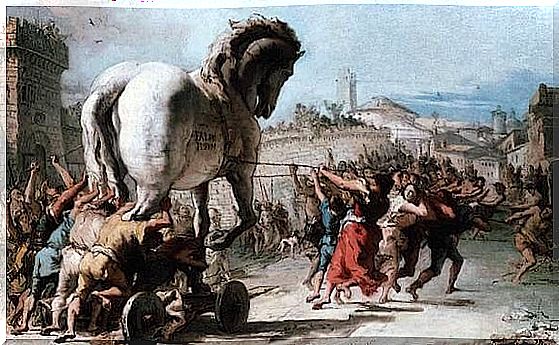The Characters Of Greek Mythology Tell Us About The Risk

Risk is defined as the amount of potential damage associated with a given situation. In other words, what could happen by doing harm. Knowing the risks of a situation can help us avoid them or, at least, be prepared to face them. Following this approach, Klinke and Renn described six types of risk using characters from Greek mythology of the 700 and 500 BC.
These mythological figures represent the desire of the human being to be aware of himself and to create his own future, rather than being at the mercy of luck and circumstances. There are six different types of risk represented by Damocles, Cyclops, Pythia, Pandora, Cassandra and Medusa. These risks differ from each other in the likelihood of occurrence, the damage they can cause and what we know about them.
Below we will see the characters from Greek mythology that Klinke and Renn have associated with the six different types of risk.
Characters from Greek mythology tell us about risk

Damocles
Damocles was a courtier of Dionysius I, tyrant of Syracuse. He claimed that his king was extremely fortunate in having power and wealth, which made him an envious and flattering individual of Dionysius. To teach him a lesson, he proposed that Damocles take his place for just one day.
That same evening a banquet was held in which Damocles delighted to be treated like a king. However, at the end of the meal, he noticed a sharp sword hanging over his head and tied to a thin strand of horsehair. Suddenly he lost all interest in delicacies and luxuries and asked Dionisio to be allowed to give up his post.
This myth helps to describe the insecurity and responsibilities to which those who hold great power are subjected. They risk losing not only their supremacy, but also their lives.
This danger is typical of times of prosperity. Its main characteristics are the low probability of its occurrence and the significant amount of potential damage. Some examples of this risk are found in nuclear energy or in the impact of a meteorite. They are unlikely to happen, but if they do, the damage will be enormous.
Cyclops
Cyclops are giants with only one eye in the middle of the forehead. Having reduced vision, they also have a reduced perception of reality. This myth describes a risk that cannot be well estimated. The probabilities of occurrence are unknown, but the potential damage is known to be catastrophic.
This type of risk includes earthquakes, volcanic eruptions and the use of weapons of mass destruction. We’re not sure if and when they will happen, but we know the damage will be devastating.
Pythia
When the Greeks wanted to know the future, they consulted their oracles. One of the most important was the oracle of Delphi, whose priestess was Pythia. She entered an altered state of consciousness due to the gases escaping from the ground, and from this state she made her predictions, warning of the impending future. However, unfortunately for those who consulted the oracle, the prophecies were always ambiguous.
The risk represented by this myth corresponds to that of which the extent of the damage or the probability of occurrence is unknown. An example is found in sudden climate change or exposure to chemical or biological substances. These risks, as well as those related to technology, for example derived from genetic engineering, are extremely difficult to estimate.
Pandora, among the characters of Greek mythology, tell us about risk
Pandora is one of the most controversial characters in Greek mythology. It was created by the gods as a form of punishment after Prometheus stole their fire to give it to humanity. Pandora was so beautiful that neither gods nor humans could resist her. For this reason, the gods of Olympus gave her their best gifts, including curiosity. It was this, however, that led her to open the vessel that contained all the evils of the world.
This risk indicates that even small gestures can cause serious disasters. Typically, these risks are discovered when it is too late, such as those caused to the environment. The characteristics of this type of risk are high diffusion, persistence over time and irreversibility. An example are chlorofluorocarbons: at the beginning they were considered harmless, but over time it has emerged that they are responsible for the destruction of the ozone layer.
Cassandra
Cassandra was a seer of the city of Troy who was cursed by Apollo; this curse was that no one would ever believe his predictions. It was she who predicted the fall of Troy at the hands of the Greeks, but her compatriots did not take her seriously. Subsequently, as is known, the Greeks donated the famous wooden horse to the city and razed the city to the ground.
This myth corresponds to events for which the probabilities of occurrence and the extent of the damage are known. However, as there is a delay between the cause and the consequences, the risk is ignored or underestimated. Risks of this type also have a high probability of occurrence and a high potential damage. Examples of this are climate change and biodiversity loss.

Medusa, the last of the characters from Greek mythology to talk to us about risk
The last of the mythological characters of which we speak is Medusa, one of the three Gorgons, the only mortal among them. No one dared to approach her, because her gaze was said to be able to petrify anyone who met it.
The type of risk associated with this myth is that linked to the rejection of certain technological innovations despite the blatant harmlessness. In other words, a risk that appears high, but for which there is no evidence. An example is electromagnetic fields. The potential for harm is low, but many people feel affected.
As we have just seen, the different risks can be represented by these analogies with the characters of Greek mythology. However, comparisons are not so important as knowing what risk each of these categories corresponds to in such a way as to avoid potential damage: both the feared and the one deriving from the anticipation of the same.









